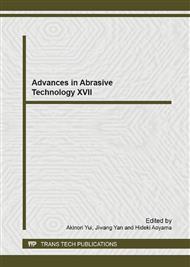p.243
p.249
p.255
p.261
p.267
p.273
p.281
p.287
p.292
Evaluation of Grinding Performance by Mechanical Properties of Super Abrasive Wheel - Relationship between Modulus of Rupture and Critical Grain Holding Power (2nd Report)
Abstract:
This study was examined about the relationship between the fillers added to the grain layer of a resinoid bond diamond wheel and mechanical properties, the grade, the grinding performance. In the abrasion test using a constant pressure grinding, it was shown clearly that the critical grain holding power changed by kinds of fillers. On the other hand, in the constant cut surface grinding, the grinding interval was evaluated based on the grinding force. And, it was confirmed that the grinding interval changed by kinds of filler. Also, it was found that the characteristics of truing and dressing changed by kinds of filler. In addition, Young's modulus and bending strength of the grain layer of a resinoid bond diamond wheel was measured by three point bending test and ultrasonic pulse method. In the results, it checked that the mechanical properties such as bending strength and Young's modulus of a grain layer changed by kinds of filler. And, the modulus of rupture was calculated from the Young's modulus and bending strength.The result of having compared the modulus of rupture with the critical grain holding power, it was found that the modulus of rupture and the critical grain holding power have good correlation. Namely, the critical grain holding power of a resinoid bond diamond wheel can be evaluated by the modulus of rupture. Furthermore, it was shown that the grinding performance may be able to be predicted by the modulus of rupture of a grain layer of a resinoid bond diamond wheel.
Info:
Periodical:
Pages:
267-272
Citation:
Online since:
September 2014
Authors:
Price:
Сopyright:
© 2014 Trans Tech Publications Ltd. All Rights Reserved
Share:
Citation:


